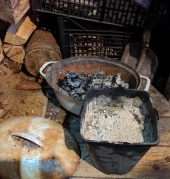Baking soda is sodium bicarbonate. When you heat sodium bicarbonate above 212 deg F for an extended period of time, 2NaHCO3 -> Na2CO3 + CO2 + H2O; Na2CO3 is not lye, it is commonly referred to as soda ash. Lye is the common name sodium hydroxide. Lye is a much stronger alkaline than soda ash, however, soda ash is a strong alkaline as well. Baking sodium bicarbonate is complete when you have lost approx 1/3 of the weight you started with. The reaction does not occur until the temp is above 176 deg F, and the higher the temp, the faster the reaction. The lye produced from wood ash is actually a complex mixture of soluble sodium, magnesium and potassium hydroxide salts, sodium hydroxide being the strongest alkali. The pH of the solution for is what counts, whether it is from soda ash or lye. For ramen noodles, for example, in 35 g of water, add 0.75 g of baked sodium bicarbonate. Some recipes include adding potassium carbonate, as well. The pH of the solution should be at least 11.6 or higher for ramen noodles. Pretzel water pH needs to be around 9.0, according to one recipe I found online. For pretzels, only the surface needs to be affected but in noodles, there is a chemical reaction with the proteins in the flour that needs to occur and needs a high pH. In fact, in ramen, sodium carbonate causes the noodles to soften whereas potassium carbonate causes the noodles to stiffen. Using both potash (potassium carbonate) and soda ash (sodium carbonate) gets the proper texture, I guess.
Tom Bachey



